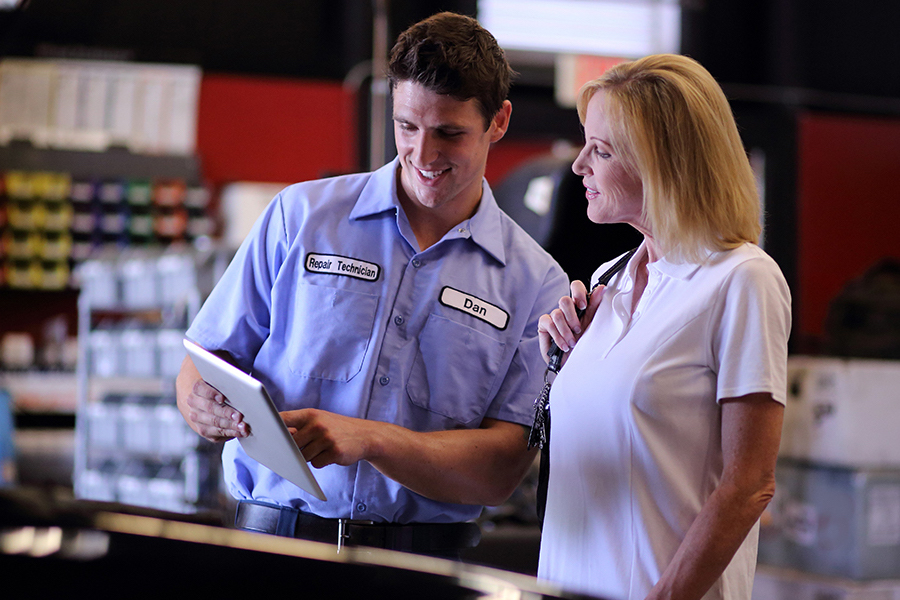September sales decline but SAAR stays steady; the dealership of the future starts with service; 2020 fixed ops trends to consider
If September results are any indication, this year’s new car sales roller coaster is on a pretty steep downward run, thanks to the high price of new cars and the cost of borrowing. According to Automotive News, in fact, virtually every automaker reported declines for the month of September – even Subaru, which had scored positive sales results every month since 2011. They were down 9.4%, but larger automakers saw even deeper losses: Toyota dropped an overall 17%, Ford an estimated 12%, and GM an estimated 10%.
Most analysts blamed the high price of new cars, along with interest rates and the short sales month – Labor Day Weekend sales were counted in August this year. That shift resulted in 10% more August sales, a boost promptly given back with a 12% overall loss in September. Via Automotive News, here’s what Edmunds analysts have to say:
“All year long we’ve been talking about high prices and rising interest rates keeping shoppers on the sidelines, but in the third quarter those pressures eased up just enough to get consumers back in a buying mood. If this momentum continues, we expect a solid finish to the year.”
— Jeremy Acevedo, Edmunds’ senior manager of industry analysis
Indeed, there is a silver lining: first, even with the sales decline, SAAR topped 17 million for the fifth time. And if pricing/interest rate pressure eases into the fourth quarter, dealerships could very well see purchase-ready buyers.
Read the Automotive News article here.
The Dealership of the Future Starts with Service
To hear McKinsey & Company tell it, the practice of selling cars at a dealership is fading away, under pressure of profit erosion and disruptive technologies. In an article entitled “As dramatic disruption comes to automotive showrooms, proactive dealers can benefit greatly” McKinsey & Co. researchers found that dealership profit erosion and competitive forces are already forcing change. Here’s an excerpt:
“Average dealership operating profits plunged from 8.9 percent in 2015 to 1.7 percent in the first half of 2018, while gross profits fell from 3.3 percent to 2.4 percent over the same period. Dealership sentiment is also shifting from optimism to pessimism based on the most recent industry research.”
The article examines sales pressures and the shifting automotive marketplace, including disruptors in the market like Carvana, and third-party digital channels. As a result, they found that successful dealerships in the future will need to get creative and leverage technology to create new profit centers – all while relying on a streamlined and modern version of the service department. Of that, the report is clear: Consumers prefer going to dealership service centers, and millennials do not like to take care of their own vehicles. Here’s what McKinsey says about it:
We also project that the combined “do it for me” maintenance-service and aftermarket-parts profit pool will grow from about $40 billion to between $42 billion and $46 billion in 2030, while franchise service and parts will grow from $54 billion to between $57 billion and $60 billion, due to the growing number of cars on the road and increased parts costs.
The bad news? By 2030, increases in battery electric vehicles will partially offset gains made by service.
Read the McKinsey & Company article here.
2020 Fixed Ops Trends to Consider
If the future looks bright for service drives, the near future – as in next year – looks even better, just as long as managers pay attention to changes in consumer patterns, embrace technology, and focus on customer service. According to an article on CBTNews.com, here are a few trends to consider for Q4 2019 – and as we turn toward 2020:

Price Increases: As new car prices go up, so to will used car prices. Per Thinknum Alternative Data: “The average price of a used car for the months of June, July, and August 2019 was right around $22,000, at least $1,000 more than the summer of 2018.” Increases in used vehicle sales and prices generally mean higher reconditioning costs.
Millennials: As millennials continue to settle down into jobs and homes, the one thing they aren’t doing is vehicle service – there just aren’t as many weekend oil changes happening on driveways in the suburbs anymore. For example, an Ally Financial survey showed that millennials and Generation Z paid an average of $2,334 for vehicle maintenance and repairs in the past five years.
Read the CBTNews article here, and the Auto ReMarketing article here.
What’s Next?
Click here to learn more about Dealer-FX ONE Platform. At Dealer-FX, our mission is to help automotive dealerships transform the customer experience by providing leading-edge marketing services that help to deliver the right message at the right time — via the right digital channel. How can we help you?
